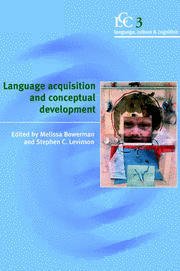Description
Language Acquisition and Conceptual Development
Language Culture and Cognition Series
Coordinators: Bowerman Melissa, Levinson Stephen
Leading scholars examine the relationship between child language acquisition and cognitive development.
Language: English
Subject for Language Acquisition and Conceptual Development:
Language acquisition & conceptual development
Publication date: 01-2001
616 p. · 15.4x22.8 cm · Paperback
Publication date: 01-2001
616 p. · 15.4x22.8 cm · Paperback
Language acquisition and conceptual development
Publication date: 01-2001
616 p. · 15.6x23.6 cm · Hardback
Publication date: 01-2001
616 p. · 15.6x23.6 cm · Hardback
Description
/li>Contents
/li>
Recent years have seen a revolution in our knowledge of how children learn to think and speak. In this volume, leading scholars from these rapidly evolving fields of research examine the relationship between child language acquisition and cognitive development. At first sight, advances in the two areas seem to have moved in opposing directions: the study of language acquisition has been especially concerned with diversity, explaining how children learn languages of widely different types, while the study of cognitive development has focused on uniformity, clarifying how children build on fundamental, presumably universal concepts. This book brings these two vital strands of investigation into close dialogue, suggesting a synthesis in which the process of language acquisition may interact with early cognitive development. It provides empirical contributions based on a variety of languages, populations and ages, and theoretical discussions that cut across the disciplines of psychology, linguistics and anthropology.
Preface; Introduction; Part I. Foundational Issues: 1. The mosaic evolution of cognitive and linguistic ontogeny Jonas Langer; 2. Theories, language, and culture: Whorf without wincing Alison Gopnik; 3. Initial knowledge and conceptual change: space and number Elizabeth S. Spelke and Sanna Tsivkin; Part II. Constraints on Word Learning?: 4. How domain-general processes may create domain-specific biases Linda B. Smith; 5. Perceiving intentions and learning words in the second year of life Michael Tomasello; 6. Roots of word learning Paul Bloom; Part III. Entities, Individuation, and Quantification: 7. Whorf versus continuity theorists: bringing data to bear on the debate Susan Carey; 8. Individuation, relativity, and early word learning Dedre Gentner and Lera Boroditsky; 9. Grammatical categories and the development of classification preferences: a comparative approach John A. Lucy and Suzanne Gaskins; 10. Person in the language of singletons, siblings, and twins Werner Deutsch, Angela Wagner, Renate Buchardt, Nina Schultz and Jörg Nakath; 11. Early representation for all, each, and their counterparts in Mandarin Chinese and Portuguese Patricia J. Brooks, Martin D. S. Braine, Gisele Jia and Maria da Graca Dias; 12. Children's weak interpretations of universally quantified questions Kenneth F. Drozd; Part IV. Relational Concepts in Form-Function Mapping: 13. Emergent categories in first language acquisition Eve V. Clark; 14. Form-function relations: how do children find out what they are? Dan J. Slobin; 15. Cognitive-conceptual development and the acquisition of grammatical morphemes: the development of time concepts and verb tense Heike Behrens; 16. Shaping meanings for language: universal and language-specific in the acquisition of spatial semantic categories Melissa Bowerman and Soonja Choi; 17. Learning to talk about motion UP and DOWN in Tzeltal: is there a language-specific bias for verb learning? Penelope Brown; 18. Finding the richest path: language and cognition in the acquisition of verticality in Tzotzil (Mayan) Lourdes de León; 19. Covariation between spatial language and cognition, and its implications for language learning Stephen C. Levinson; Indexes.
© 2024 LAVOISIER S.A.S.




